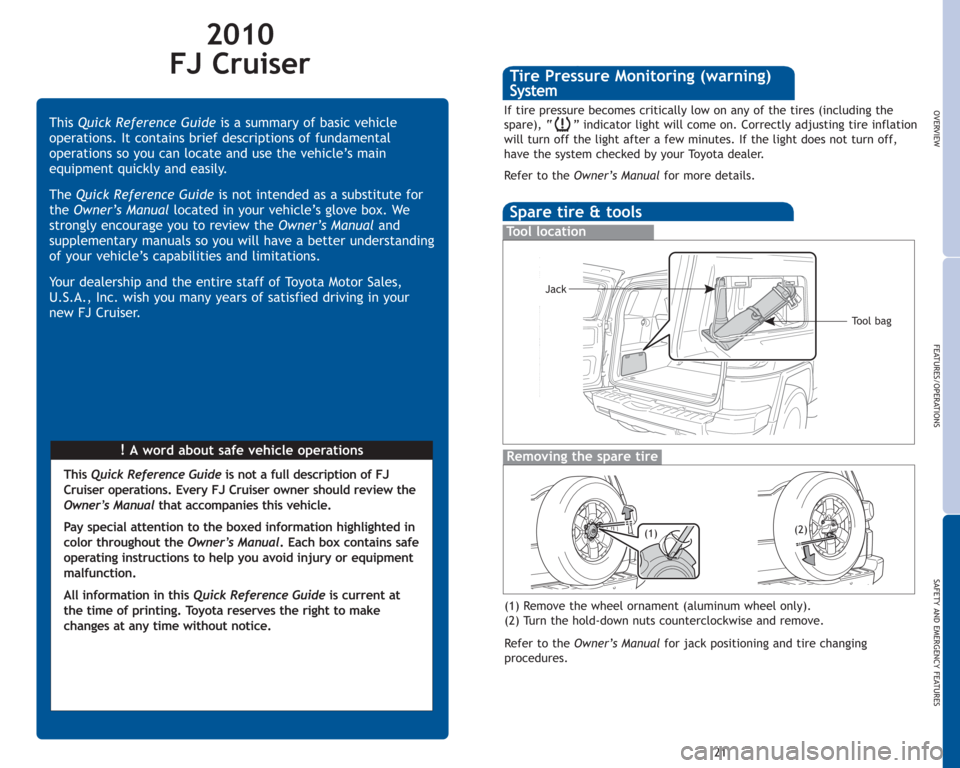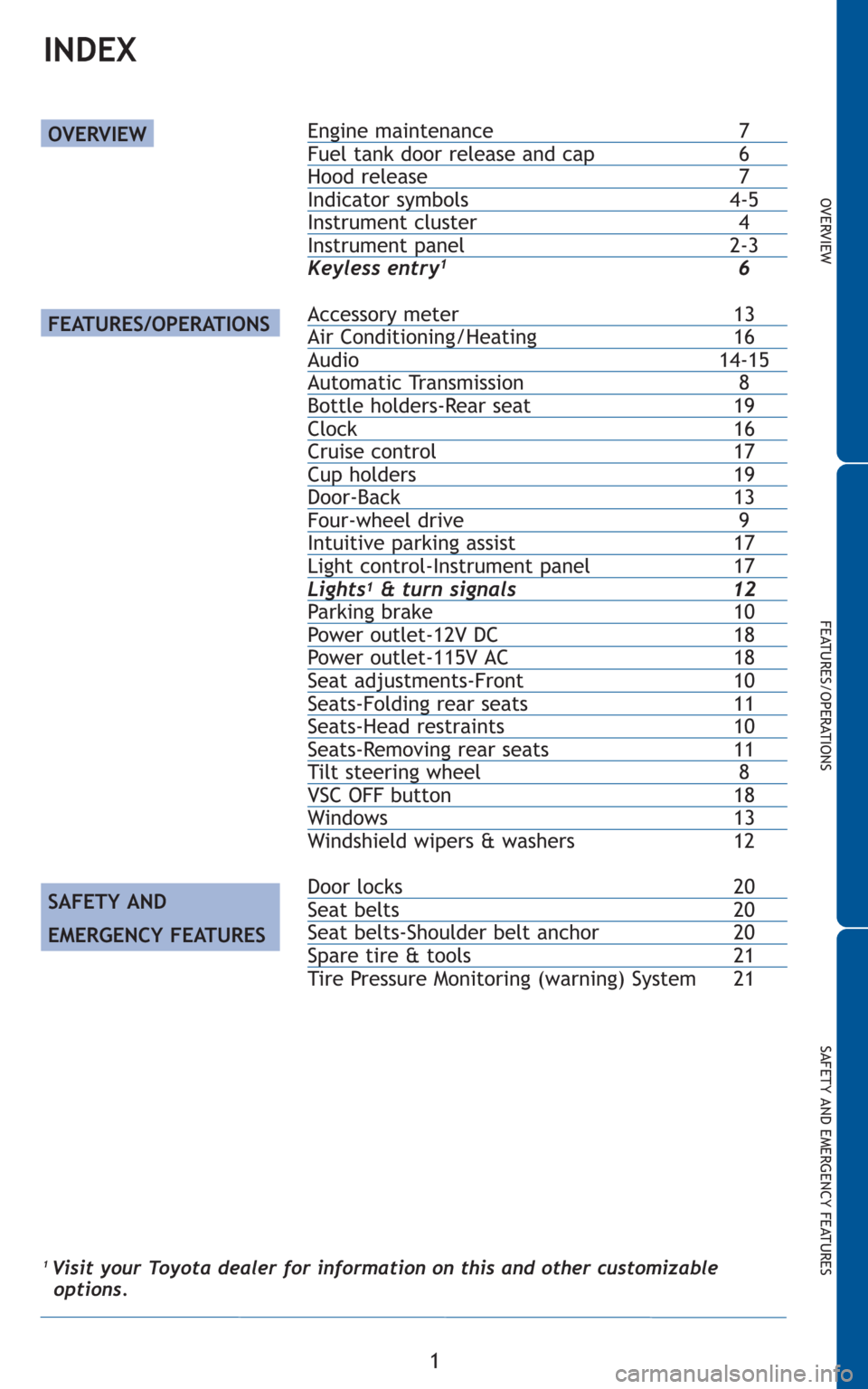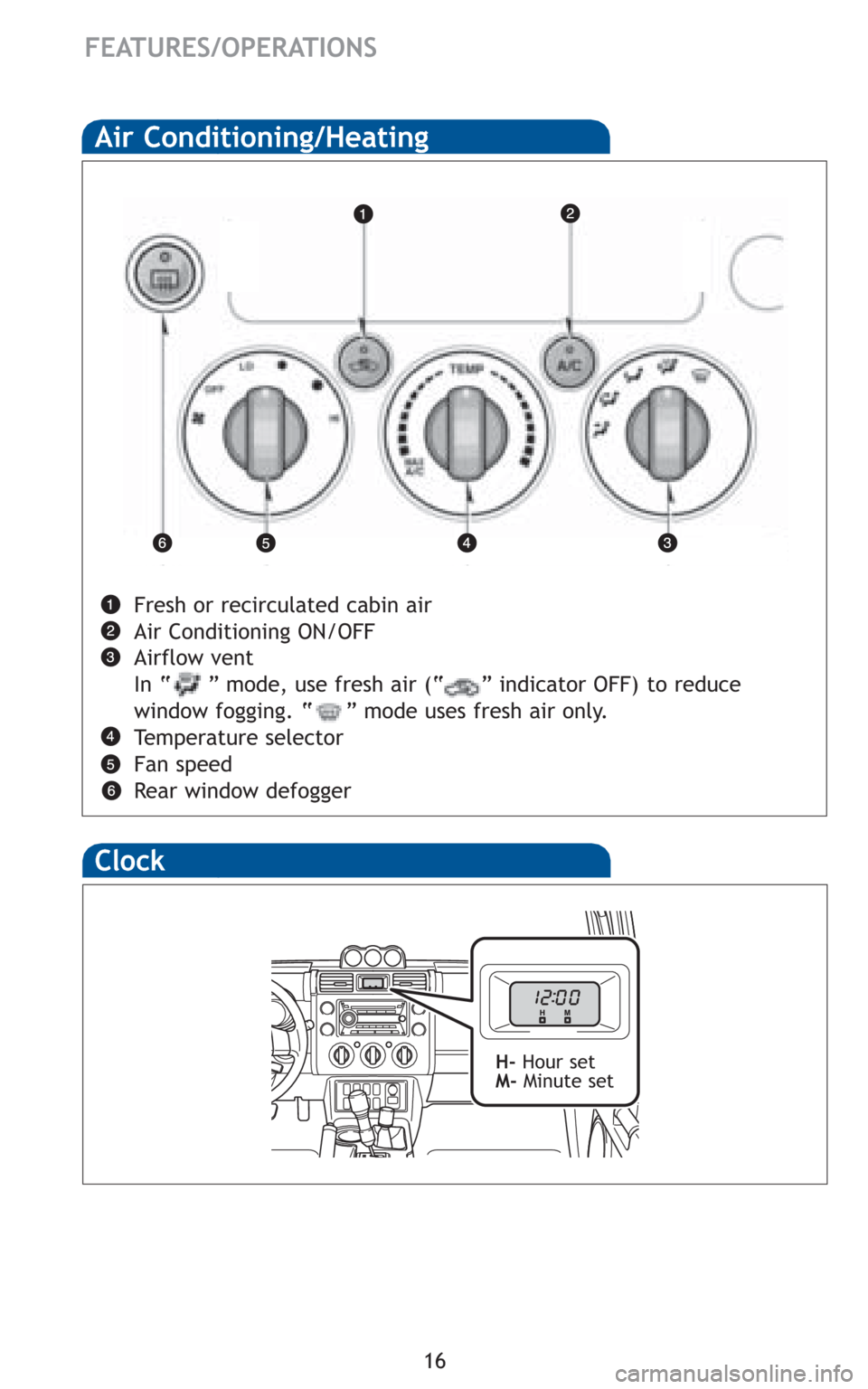clock TOYOTA FJ CRUISER 2010 1.G Quick Reference Guide
[x] Cancel search | Manufacturer: TOYOTA, Model Year: 2010, Model line: FJ CRUISER, Model: TOYOTA FJ CRUISER 2010 1.GPages: 22, PDF Size: 1.01 MB
Page 2 of 22

2010
FJ Cruiser
!Awordaboutsafevehicleoperations ThisQuick Reference Guideis a summary of basic vehicle
operations. It contains brief descriptions of fundamental
operations so you can locate and use the vehicle’s main
equipment quickly and easily.
TheQuick Reference Guideis not intended as a substitute for
theOwner’s Manuallocated in your vehicle’s glove box. We
strongly encourage you to review theOwner’s Manualand
supplementary manuals so you will have a better understanding
of your vehicle’s capabilities and limitations.
Your dealership and the entire staff of Toyota Motor Sales,
U.S.A., Inc. wish you many years of satisfied driving in your
new FJ Cruiser.
ThisQuick Reference Guideis not a full description of FJ
Cruiser operations. Every FJ Cruiser owner should review the
Owner’s Manualthat accompanies this vehicle.
Pay special attention to the boxed information highlighted in
color throughout theOwner’s Manual. Each box contains safe
operatinginstructionstohelpyouavoidinjuryorequipment
malfunction.
All information in thisQuick Reference Guideis current at
the time of printing. Toyota reserves the right to make
changes at any time without notice.
OVERVIEW
FEATURES/OPERATIONS
SAFETY AND EMERGENCY FEATURES
21
Sparetire&tools
Tool location
Removing the spare tire
(1) Remove the wheel ornament (aluminum wheel only).
(2) Turn the hold-down nuts counterclockwise and remove.
RefertotheOwner’s Manualfor jack positioning and tire changing
procedures.
If tire pressure becomes critically low on any of the tires (including the
spare), “ ” indicator light will come on. Correctly adjusting tire inflation
will turn off the light after a few minutes. If the light does not turn off,
have the system checked by your Toyota dealer.
RefertotheOwner’s Manualfor more details.
Tool bag Jack
(2)
(1)
Tire Pressure Monitoring (warning)
System
Page 3 of 22

1
INDEX
Engine maintenance 7Fuel tank door release and cap 6Hood release 7Indicator symbols 4-5Instrument cluster 4Instrument panel 2-3
Keyless entry16
Accessory meter 13Air Conditioning/Heating 16Audio 14-15Automatic Transmission 8Bottle holders-Rear seat 19Clock 16Cruise control 17Cup holders 19Door-Back 13Four-wheel drive 9Intuitive parking assist 17Light control-Instrument panel 17Lights1& turn signals 12Parking brake 10Power outlet-12V DC 18Power outlet-115V AC 18Seat adjustments-Front 10Seats-Folding rear seats 11Seats-Head restraints 10Seats-Removing rear seats 11Tilt steering wheel 8VSC OFF button 18Windows 13
Windshield wipers & washers 12
Door locks 20Seat belts 20Seat belts-Shoulder belt anchor 20Spare tire & tools 21
Tire Pressure Monitoring (warning) System 21
OVERVIEW
FEATURES/OPERATIONS
SAFETY AND EMERGENCY FEATURES
OVERVIEW
FEATURES/OPERATIONS
SAFETY AND
EMERGENCY FEATURES
1Visit your Toyota dealer for information on this and other customizable
options.
Page 4 of 22

OVERVIEW
Instrument panel
2 Instrument panel light control
Power rearview mirror controls*
Clutch start cancel switch*
Roll Sensing of Curtain shield Airbag OFF switch
Tilt steering lock release
Headlight and turn signal control
Wiper and washer controls
Ignition switch
Emergency flasher button
Clock
Front passenger seat belt reminder light
Audio system
Engine immobilizer indicator
Air Conditioning controls
Rear window defogger button
VSC OFF switch*
Steering wheel controls
(if equipped)
Page 18 of 22

16
FEATURES/OPERATIONS
Clock
H-Hour set
M-Minute set
Air Conditioning/Heating
Fresh or recirculated cabin air
Air Conditioning ON/OFF
Airflow vent
In “ ” mode, use fresh air (“ ” indicator OFF) to reduce
window fogging. “ ” mode uses fresh air only.
Temperature selector
Fan speed
Rear window defogger